JUNE 2020 ENEWS
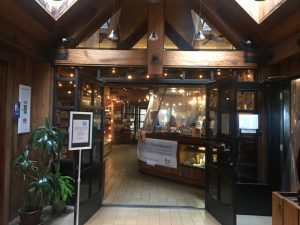
Dear friends of Salt Point and Fort Ross,
I am sneaking in our June newsletter just under the wire. Being late isn’t great and it’s messed with the news pegs for two very interesting e-news stories - unfortunately National Pollinator Week and California Invasive Species Action Week are squarely in our rear view mirror -- but the upside is that I get to announce the opening of the Fort Ross Visitor Center and bookshop , starting tomorrow! The park grounds, beaches, and trails have been open for several weeks. The stockade gate to the fort compound is open but the fort buildings remain closed for now. Thankfully, starting this week we can swing open the doors to the visitor center and museum, following county rules on social distancing and mask wearing. For the safety of everyone, we ask that you wear a mask while inside all buildings and you practice social distancing - no gatherings or large picnics please.
Salt Point is open as well, and we anticipate the campgrounds will open by mid July. While there will be roving State Parks interpreters to field your questions at Salt Point, we won’t be opening the Gerstle Cove Visitor Center just yet.
Thanks go to Parks California for their support in helping us prepare for this big day.
Next month we should be celebrating Fort Ross Festival, our annual bash, canceled due to Covid-19. Such a disappointment! FRC has been effectively shut down since mid March - no school groups, bookshop sales, tours, or firewood sales. Instead we’ve been writing lots of grants, working on revising our school curriculum and programs to adapt to the post-Covid world, and trying to second guess what tomorrow might bring. We received the SBA Payment Protection Plan and that was very helpful to keep the team working remotely for the last two months. But Fort Ross and Salt Point are all about place, and we are looking forward to reacquainting ourselves with these special lands. We hope you and your family head west to Fort Ross to enjoy a day of hiking with the cool Pacific breeze to keep you comfortable.
Keep scrolling for this month’s stories - an epic historic shipwreck, the tale of teasel and its many uses, and a colorful reminder of the important and varied role of pollinators.
Be well, be safe,
-Sarah
Sarah Sweedler
Fort Ross Conservancy CEO
‘Striking spectacle!’ Remembering the Il'mena Shipwreck of 1820
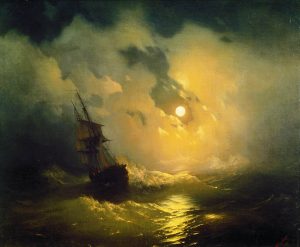
Two hundred years ago one of the earliest recorded shipwrecks in Californian history occurred off Point Arena when a 200-ton brig Il’mena , belonging to the Russian American Company (RAC), ran aground in stormy weather just 40 miles north of Fort Ross on the night of June 18, 1820. The details of events of that fateful night recorded by one of the most senior agents in RAC’s service, Kirill Klebnikov, are worthy of the best Hollywood screenplays, as it all started on a gloomy summer night two weeks after the 90-foot brig set sail from Sitka, Alaska to deliver dozen of settlers and cargo to the shores of the New Albion.
Most of the journey from Sitka was uneventful until June 18 when the crew, commanded by an American Captain Christopher Stevens, sighted the shoreline of the Mendocino coast at 2:30pm amid thick fog that crept over the dunes and the mountain range. To reach the Russian settlement the captain decided to hold 6 miles from the shore but by 9:00 pm, when the brig was speeding at 5 knots/hr, Captain Stevens ordered to “lie” until dawn so as not to miss Fort Ross. Lying ahull was a method used in the old days to weather a storm and involved downing all sails, battening the hatches, and locking the tiller. A sea anchor is not used during such maneuvering to allow the boat to drift freely, completely at the mercy of the storm. By 11:15 the storm had taken control of the ship, trapping it behind the cape and projecting reef of present-day Point Arena. After several desperate but failed tacking maneuvers, the vessel was grounded in the surf zone just north of the cape.
“I heard someone shout ‘land!’ It was a foggy night, and I could just make out mountains, which seemed to be in front of us and close, but at that moment the ship turned to go on a starboard tack. While turning we suddenly saw in front of us a cape projecting out into the sea and a reef behind it,” Khlebnikov recorded in his journal. “During the last tack, we noticed that the cape and the reef in front of us were closer...the waves were carrying us toward the shore.”
In a desperate effort to save the ship Captain Stevens ordered the anchor to be cast, but it was already too late. “The anchor broke loose, and shortly thereafter, we felt a blow. With the first impact against the shoal, the waves began to pour into the boat from the stern, and the rudder unhinged. General confusion followed. The mainmast started to break and then fell down, snapping in two. The topmast dangled from the starboard side across the ship for a long moment and was then carried off by enormous waves. The tiller lashed back and forth, and we were unable to find tools fast enough to remove it from its fitting. Then the foremast came down with a crash,” Khlebnikov wrote.
Panic followed as everyone scrambled to the top deck to be saved. One of the Hawaiian natives on board “jumped in with a rope and began to swim” to shore, battling the waves to reach land. Soon after others followed. Once on shore they lit fire, signaling the captain to proceed with the rescue effort of the crew and passengers, and of the cargo as well.
“The crew, the passengers and even the boys were all on deck, except for the women, and of course the Almighty alone saved each and every one of us from the deadly blows that rained down on us from the fragments of the masts, the waves crashing over the ship and the heavy tossing caused by the breakers,” Khlebnikov wrote. “The Captain gave the order to save the women and children among the 21 passengers, who were bound for Fort Ross, and also the four apprentices, making 25 in all.”
Despite horrors of the imminent doom, women, unlike some of the men, showed exemplary composure, maintaining “an astonishing presence of mind”. Not only did they “not cry like the others”, but they also selflessly rushed back into the stormy water to help bring the survivors ashore. Their heroic behavior was in stark contrast to the actions of some of the sailors who could not help but gulp down the rum as they refused to let the kegs get consumed by Poseidon. Despite the binge drinking fiasco in the middle of the life-threatening emergency, the remaining passengers and crew were quickly transferred to shore where they spent the remainder of the night in the shelter of the sand dunes. All 63 people on board Il’mena were saved.
“What could be a more striking spectacle than a shipwreck!” Khlebnikov observed. “If the shipwreck had occurred two cable-lengths to the right, not a single person would have been saved. A reef projecting far out into the sea would have crushed the ship, and there would have been no chance of surviving.”
Once on dry land, Khlebnikov demonstrated superb managerial skills by immediately ordering the erection a temporary shelter camp, setting up hunting parties to fetch provisions, and assembling salvage crews to safe the cargo of Il’mena that was bringing construction material to Ross to complete the brig Buldakov that was being constructed by the Russians in California. RAC’s agent also managed to secure a communication line with Fort Ross to get immediate help from the outpost. Help arrived right away. The next two weeks were spent rescuing everything that was salvageable from the Il’mena which laid capsized on the sandy ocean floor. Alaska Natives sent by Fort Ross’ manager Ivan Kuskov did the lion share’s of the labor which was highly praised by Khlebnikov in his notes.
“When the work was finished, I thanked the Aleuts most warmly for their diligence and active help, without which we would not have been able to carry any load over 20 or 30 puds,” Khlebnikov wrote. “I asked Ivan Aleksandrovich [Kuskov] whether we could reward the Aleuts for their diligent help in unloading and transporting the ship's cargo by giving them one pound of tobacco each, and as he approved, I ordered Sukhanov to distribute two puds of tobacco...Earlier, I had given the Aleuts eight arshins of Flemish cloth for their help in unloading the ship. Today, with Mr. Kuskov's permission, I gave 15 arshins to three men and left Mr. Kuskov another 18 arshins to give to those who had made the greatest effort and had been the most obedient.”
The next two months the Russian American Company spent assessing the state of the wreck and devising a plan to rescue the ship to potentially repair it for future use. That endeavor proved fruitless. The Pacific Ocean has claimed the Il’mena .
The lost ship has now become a prized lure of treasure hunters and archaeologists alike as they continue their quest to find two cannons and other items that were supposedly lost during the incident. So far, remnants of the ship that graced the world’s oceans for 23 years have not been found.
The 200-ton vessel was built in the East Indies in 1797 before it sailed across half of the world to New England where Bostonians put the ship to work. Called the Lydia under the American command the brig had an exemplary resume of distinguished service and has engaged in trade and hostage rescues, and even acted as an important messenger by delivering Lewis and Clarks’ notes on their great expedition across the continent to President Thomas Jefferson in 1806. The vessel had been purchased by RAC for seal skins in late 1813 and renamed the Il’mena . It was instrumental in Russian exploration of the Pacific, sailing between Alaska, California and Hawaii on a number of occasions. The ship was apparently in good shape when it ran aground.
In case some of you wonder, Captain Stevens was blamed for the incident and was discharged from service of the Russian American Company following the shipwreck. “The cause of the shipwreck of the brig Il’mena was, of course, the captain himself, for he did not have all of the means for determining his position exactly, and by nightfall, after having sighted the coast, he should have laid at sea until daylight – which would have been very easy to do – but he did not do this and struck the sandbank at Point Arena,” Fort Ross Manager Ivan Kuskov said in this report of the incident. “Many causes conspired in the wrecking of the brig, including the crew’s misunderstanding, the speed of the ship, the wind, and perhaps an unknown sea current – all of these circumstances could have happened to even the best ship’s captain but probably not to a cautious one.”
Full account of Il’mena’s s hipwreck is found in a book titled : Khlebnikov Archive: Unpublished Journal (1800-1837) and Travel Notes (1820, 1822, and 1824) , University of Alaska Press; 1st edition (August 1, 1990)
Painting by Ivan Aivazovsky, Stormy Sea at Night , 1849, Pavlovsk Palace, Saint Petersburg, © Wikipedia
-- Igor Polishchuk , Director of External Relations and Community Partnerships
Invasive Species Week Highlights the Teasel
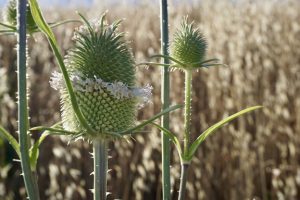 The more you get to know your local flora and fauna, inevitably you learn that quite a few species we consider common are, in fact, non-native and invasive. Invasive species are those that have been brought in from other (non-indigenous) locations which often, though not always, adversely affect a habitat. Sometimes this is done inadvertently - for example, the European grass seeds on the hooves of livestock have now nearly replaced all our California native grasses. Other times it’s done intentionally, usually for some economic purpose, such as with one such species you’ll find on the ridgeline of Fort Ross State Historic Park--the Fuller’s Teasels (Dipsacus sativus).
The more you get to know your local flora and fauna, inevitably you learn that quite a few species we consider common are, in fact, non-native and invasive. Invasive species are those that have been brought in from other (non-indigenous) locations which often, though not always, adversely affect a habitat. Sometimes this is done inadvertently - for example, the European grass seeds on the hooves of livestock have now nearly replaced all our California native grasses. Other times it’s done intentionally, usually for some economic purpose, such as with one such species you’ll find on the ridgeline of Fort Ross State Historic Park--the Fuller’s Teasels (Dipsacus sativus).
Teasels are native to Europe and temperate Asia. They are a biennial plant that can grow up to six feet tall under ideal conditions. At first glance they look similar to a thistle but they are substantially more sturdy. Their flower head is what makes them stand out. Each formidable topper can reach up to four inches long by two inches wide. The entire oval is covered with hard, hooked spines reminiscent of some sort of hedgehog or pincushion.
On each flower head, tiny white/lavender flowers start by opening in a band around the middle of the inflorescence (arrangement of flowers on an axis). As these flowers wilt and die, the band above and below begin to bloom. The flower head continues like this with bands of tiny flowers opening, traveling in opposite directions. Each of these flower heads can easily produce 3,000 seeds which can survive for six years or longer in the soil.
Teasels are reportedly partially carnivorous plants! Stuhmiller writes, “The genus name Dipsacus is derived from the Greek for “thirst,” a reference to the cup-like leaf bases that fill with rainwater. These phytotelmata, as such tiny pools are known, may be designed to discourage aphids from climbing the stem. They often contain the bodies of unfortunate invertebrates which the teasel seems to be able to digest, though the mechanism by which it does so is not yet known.”

Although now seen as a weed, Fuller’s teasels are native to Europe, where they were cultivated for centuries for use in textile processing. The spiny flower head dries and turns into an assertive seed head that was used to card wool. While the turnover of each teasel cross or hand carder was quite frequent (as the spines had a tendency to break) it was said the natural spines of the teasel were much more gentle on the wool than metal teethed carders. As you can see from this image found on the blog In My Lady’s Chamber: Mendel Hausbuch, f. 6v, c. 1425: Peter Berber, Carder. This clearly shows two teasel-based cards being used to raise the nap on woven cloth.
“The teasel’s common name comes from an Old English word, tæsan , meaning ‘to pull [apart].’ (It is the same root of our word ‘to tease’; composure frays under constant vexation, just as fiber does.)”writes Jacqueline Stuhmiller in the Finger Lake Land Trust newsletter.
In the nineteenth century, teasels were used to brush woven fabric (a process known as “raising the nap”) which created a luxuriant, uniform surface.
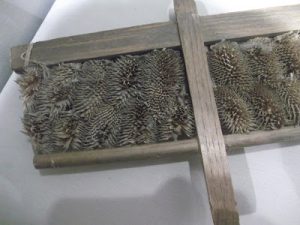
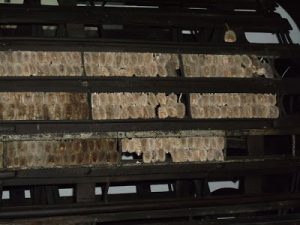

Teasels were used on an industrial scale at wool mills during the early nineteenth century. As seen in these images from the National Wool Museum in Wales, teasel heads were used in this Teasel Raising Gig, which was used in the finishing stage of woolen fabrics. Each Gig used up to 3000 teasels at a time and required a “teasel man” who traveled with the Gig, replacing each broken teasel just so, to create a uniform look on the fabric’s surface.
So, how did they get to the U.S.? There are vague reports of settlers bringing them over from Europe in the early 1700s, but nothing concrete. We know for sure that in 1830, an enterprising apothecary named Dr. James Snook realized his hometown of Skaneateles, New York had the ideal soil and climate to grow this useful crop. He imported the European variety ( D. sativus ), and soon his teasels were not only used domestically at wool mills, but also exported to Europe. According to the USDA Fire Effects Information System (FEIS), by 1907, teasels were reportedly grown in Clackamas County, Oregon, possibly accounting for the introduction of the species to our west coast.
Carlos Call was known as an exemplary sheep farmer at Fort Ross in the 1920s, though unfortunately, I could not find any reference to teasels being used at Fort Ross. Did the teasel make its way to the area simply due to the fact the settlement/ranch became such a community hub, with many out-of-towners visiting? Perhaps.
After finding this article, I was thrilled to stumble upon a comment from an anonymous source whose grandparent was in fact part of the Skaneateles community. “ My grandfather was a teasel farmer in upstate New York. The teasel was used to comb the wool fabric. In the 1960's wire replaced the teasel. If you visit the Creamery in Skaneateles, NY there's an exhibit on the teasel farmers in the area and its use in the wool industry.”
Teasels thrive in disturbed areas such as along roadsides and waterways which help to distribute their seeds. As noted by the California Invasive Species Council, “Teasel has spread rapidly in the last 20-30 years- this rapid range expansion probably was aided by construction of the interstate highway system; because of teasel's use as a horticulture plant, this has aided in its dispersal.”
Teasels are also used in flower arrangements, which is why you will often see teasels growing in or around cemeteries.
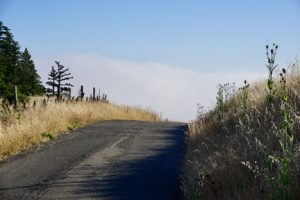 Left unchecked, teasels can form an incredibly dense monoculture that exclude all native species. The stocks and dead leaves persist year after year as they are quite woody. This thatch can shade out the sunlight, making growth of any other species impossible. So far, the population at Fort Ross has not taken over. Small populations can be controlled by removing plants to a few inches below the root crown with a sharp implement. We are fortunate that our partners with the California State Park environmental resource team prioritize the manual removal and use of herbicide to keep this population under control.
Left unchecked, teasels can form an incredibly dense monoculture that exclude all native species. The stocks and dead leaves persist year after year as they are quite woody. This thatch can shade out the sunlight, making growth of any other species impossible. So far, the population at Fort Ross has not taken over. Small populations can be controlled by removing plants to a few inches below the root crown with a sharp implement. We are fortunate that our partners with the California State Park environmental resource team prioritize the manual removal and use of herbicide to keep this population under control.
The week of June 6-14 was the seventh annual California Invasive Species Action Week, but it’s always a great time to join an invasive species removal project. If you’re inspired to get out and remove these teasels, please contact me at songh@fortross.org to set up a work day. Working together, we can return California to her abundant green indigenous state. #VisitFortRoss #InvasiveSpeciesWeek
Resources:
- UC Davis Weed Control Handbook
- USDA Common Teasel
- iNaturalist Data on Fuller’s Teasels
- In My Lady’s Chambers - Teasels for Carding - a Myth?
- California Invasive Plant Council
- Invasive Plant Atlas of the United States
- Spinspiration - National Wool Museum in Whales
-- Song Hunter , Director of Programs
Celebrating Pollinators
Nature provides endless examples of how no man--or plant, or animal--is an island. We all rely on relationships, partnerships, to survive. This lesson is abundantly clear when we look at a popular form of plant reproduction: pollination. While some plants are self-pollinating, nearly 90% of flowering plants rely on animals for pollination and therefore survival. Because so many plants, animals and people rely on the work of pollinators, the week of June 22 has been declared National Pollinator Week. To honor these most helpful creatures, I’d like to highlight a few native pollinators that can be found at Fort Ross and Salt Point State Parks:
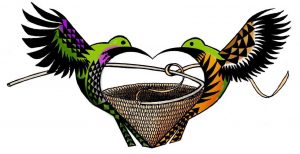 Anna’s hummingbird - There are several hummingbirds at Fort Ross and Salt Point, but the Anna’s hummingbird (Calypte anna) is our resident species and the one we see most often. Anna’s have bronze-green backs and light grey underparts. The males are more striking than the females with brilliant reddish-pink throat pouches and crowns. While observing these birds, you’ll notice the shimmering, reddish-pink feathers are visible when the sunshine is bouncing off them.
Anna’s hummingbird - There are several hummingbirds at Fort Ross and Salt Point, but the Anna’s hummingbird (Calypte anna) is our resident species and the one we see most often. Anna’s have bronze-green backs and light grey underparts. The males are more striking than the females with brilliant reddish-pink throat pouches and crowns. While observing these birds, you’ll notice the shimmering, reddish-pink feathers are visible when the sunshine is bouncing off them.
Like all hummingbirds, Anna’s have a mutualistic (mutually beneficial) relationship with the plants that they visit and feed from. Anna’s hummingbirds are attracted to plants with long, tubular flowers, especially those that are yellow, orange and red. When they feed on plant nectar, sticky pollen grains from the plants’ male parts (anther) temporarily attach themselves to the hummingbirds’ beaks and foreheads. By visiting many flowers for food, the sticky pollen gets distributed to the female parts (stigma) of many flowers, thus carrying out the process of pollination which allows these plants to reproduce.
Considering the important work pollinators do to keep the world’s plants thriving it’s not surprising that these animals are not only environmentally significant but are also culturally important. Eric Wilder, a Kashia Pomo tribal member and a prolific local artist, has written that the hummingbird or “tule (thoo-leh)...is considered a good luck bird to the coastal Pomo people. My Grandfather Sidney Parrish told me that this little bird will grant you good luck. Whenever I see the tule doing its dance I will holler to ask for good luck.” (Hummingbird design by Eric Wilder.)
Fortunately, the Anna’s hummingbird population is considered stable. If you would like to bring a bit of good luck to your backyard and to the continued health of this species you can plant nectar rich flowers that these birds flock to. Here are some hummingbird gardening suggestions from the California Native Plant Society.
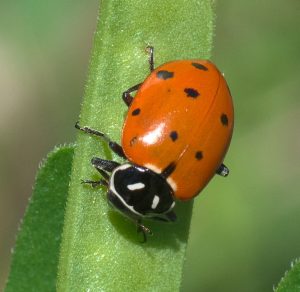
Convergent lady beetle - Many of us also consider a visit from a ladybug to be a sign of good luck, but did you know these sweet insects are pollinators? Convergent lady beetles ( Hippodamia convergens ) are one of the most common lady beetles--or ladybugs--in North America. These sweet, tiny red and black polka-dotted insects are considered highly beneficial to the environment by many farmers and gardeners. Not only do they help plants through the spread of pollen, they also eat large quantities of aphids, a well-known group of sap-sucking plant pests. Ladybugs are considered so beneficial that they are often purchased and released among food crops to help curtail destruction from aggravating aphids because their appetites provide natural and chemical-free pest control.
As a group, beetles ( Order Coleoptera ) have been benefiting the environment for a staggering length of time. According to the Xerces Society, “Fossil records suggest that beetles, along with flies, were probably the first insect pollinators of prehistoric flowering plants in the late Jurassic era, around 150 million years ago.” Perhaps the energy they carry as an ancient beneficial bug is why we feel fortunate when we’re in their presence.
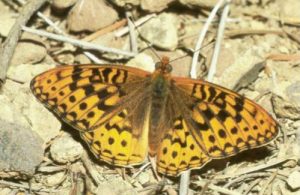 Behren’s silverspot butterfly - Butterflies are breathtaking creatures that are often thought of as magical by the way they transform during their lifecycle and seem to flit in and out of this world, but did you know they are also pollinators? According to the Naples Daily News, “[ b]utterflies pollinate during the day while flowers are open and they have a better color perception than bees or even humans. They can see red, their favorite color, while bees cannot.”
Behren’s silverspot butterfly - Butterflies are breathtaking creatures that are often thought of as magical by the way they transform during their lifecycle and seem to flit in and out of this world, but did you know they are also pollinators? According to the Naples Daily News, “[ b]utterflies pollinate during the day while flowers are open and they have a better color perception than bees or even humans. They can see red, their favorite color, while bees cannot.”
Unlike the first two pollinators highlighted which have healthy population numbers, the Behren’s silverspot butterfly ( Speyeria zerene behrensii) , a subspecies of Zerene silverspots, was listed as federally endangered in 1997. These medium-sized butterflies have golden wings marked with many black spots and lines. Historically, Behren’s have had a very limited geographic range, running along the California coastline from the Russian River in Sonoma County to around Point Arena in Mendocino County.
There is ongoing research being conducted to determine how best to help the Behren’s silverspot recover to healthy population levels. Beginning in 2017, Fort Ross Conservancy partnered with California State Park’s Natural Resource Management staff to help protect these butterflies by overseeing surveys of their partner (or host plant), the western dog violet ( Viola adunca ) at Fort Ross, Salt Point and Manchester State Parks. FRC, in partnership with California State Parks, was awarded $100,000 from Disney Foundation to restore our coastal prairie and encourage the western dog violets to thrive. While all of Fort Ross Conservancy’s survey projects, including the western dog violet, have been on hold during the COVID-19 pandemic, we hope to return to our field work soon. If you are interested in joining a citizen science project such as this, please contact Volunteer Coordinator Melissa Bushner.
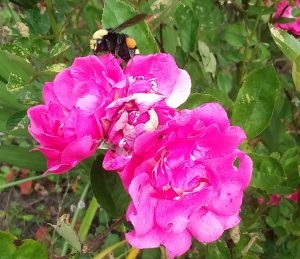
Yellow-faced bumblebee - Last but definitely not least, we have the bees, widely considered to be the most important pollinators. According to the United States Department of Agriculture (USDA), bees are responsible for the pollination of approximately 75 percent of the fruits, nuts, and vegetables grown in the United States. Check out this list of crop plants that rely on bee pollinator partnerships.
Native bees are especially important because they have naturally evolved to pollinate native plants. One of the most commonly seen native bees along the California Coast is the yellow-faced bumblebee ( Bombus Vosnesenskii ), and you can’t talk about Fort Ross pollinators without mentioning this handsome bee. The Bombus Vosnesenskii was named after the Russian explorer and naturalist Ilya Gavrilovich Vosnesenskii. During a famous expedition from 1839-1849 Vosnesenski was sent to Russian America by the Imperial Academy of Sciences to study and explore the flora and fauna of Russian America in Alaska and California. During this period of exploration Vosnesenskii collected hundreds of plants, animals and California Native cultural artifacts. Vosnesenskii was also an artist and he drew many of the sketches of Settlement Ross and the surrounding areas that serve as historical records.
This yellow-faced bumblebee photograph was taken in the Call House garden. If you look closely you can see the bee’s orange pollen sack!
Now that Fort Ross and Salt Point State Park grounds have reopened, you can come soak in the natural beauty and take a moment to celebrate the pollinators as they zip around from flower to flower, doing their essential work as partners to the plants that support us all. Once the Fort Ross Conservancy Visitor Center and Bookshop is safely reopened, we invite you to come discover the variety of enriching items on offer. We are delighted to carry Eric Wilder’s cards, prints and posters that help teach us about the cultural importance of native animals. We also have hand-selected books and field guides that can deepen your knowledge of these critical critters. Plus for a sweet pollinator treat, we have delicious honey from the Holy Assumption Monastery in Calistoga. Until then, Happy National Pollinator Week!
References and Recommendations
- US Forest Service Pollinator of the Month: Anna's Hummingbird
- California Native Plant Society: Hummingbird Gardening
- Animal Diversity Web: Convergent Lady Beetle Profile
- Xerces Society: Who Are the Pollinators
- US Dept of Agriculture: Insects and Pollinators
- US Fish and Wildlife: The Endangered Behren's Silverspot Butterfly
- USDA: Bee Basics - An Introduction to our Native Bees
Photo credits: Eric Wilder, Robert Webster (P1190651b) , Charon Vilnai
--Charon Vilnai, Programs Instructor, Sea Lion Survey Project Lead, and Call House Museum Lead
Buy a Gift Certificate from the FRC Bookshop
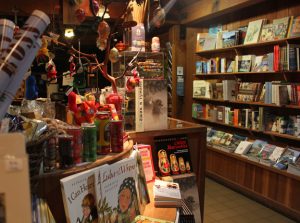
Do you enjoy reading our Newsletter? Become a member today , or call us to purchase a bookshop voucher which will help keep Fort Ross Conservancy going during the park closures.
There is a wide variety of excellent goodies in the Bookshop. For the younger naturalists there are identification playing cards and laminated fold-outs for every type of animal, flower, tree, marine mammal, bird, fish, and more. Fun and informative, engaging picture books focus on natural history and environmental issues in story form. Books on topics as wide-ranging as local, California, and Native American history; Russian America and Fort Ross history; geology, mushrooms, foraging and food, and botanical cocktails! But wait, there’s more! Local authors’ works are our favorites and we love to give them the spotlight. And when the fog rolls in, the feet need socks, and they are here: fun socks, warm socks, low and high top socks. More fun: nesting dolls, jewelry, art and photo note cards, vintage design tea towels, exquisite handmade ornaments for every season, and small to large stuffed animals. Almost forgot: unique design Tees and Hoodies, handmade hats, postcards of the local beauty, and delicious snack foods and drinks.
Email Sarjan at sarjanh@fortross.org or call at 707/847-3437.